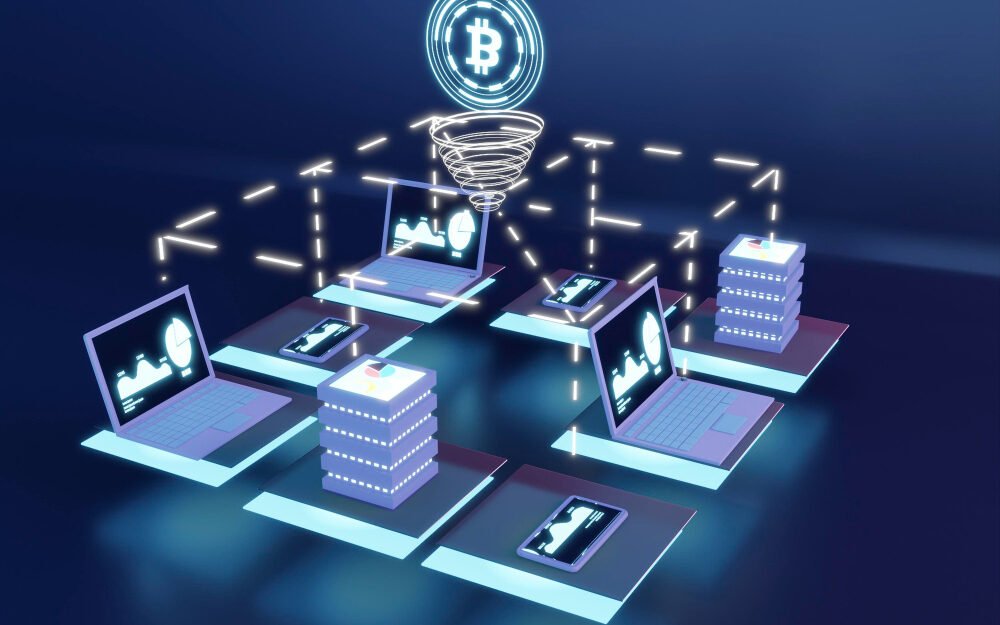
Image Credit Freepik
In a rapidly evolving digital landscape, blockchain technologies have emerged as a catalyst for innovation, redefining the foundations of trust, security, and transparency across industries. This groundbreaking technology, synonymous with cryptocurrencies like Bitcoin, transcends its origins, offering a multitude of applications beyond finance. Join us on a journey through the intricate realm of blockchain technologies, unlocking their limitless possibilities.
Understanding Blockchain: A Decentralized Revolution
At its core, blockchain functions as a decentralized and distributed ledger. Picture it as a chain of blocks, each block containing a set of transactions. These blocks are securely linked using cryptographic techniques, forming an immutable chain. The decentralized nature of blockchain, with data stored across a network of nodes rather than in a central authority, ensures transparency and resilience against tampering.
Beyond Cryptocurrencies: Diverse Applications of Blockchain

Image Credit Freepik
1. Finance and Banking Revolutionized
Blockchain’s impact on finance extends beyond cryptocurrencies. It promises faster, more secure, and cost-effective transactions. The elimination of intermediaries streamlines processes, reducing fees and settlement times. Moreover, it enables financial inclusion for the unbanked population globally.
2. Supply Chain Innovation
Industries are leveraging blockchain for transparent and traceable supply chains. Tracking products from their origin to consumers becomes seamless, reducing fraud and ensuring the authenticity of goods. Real-time monitoring and immutable records enhance efficiency and trust among stakeholders.
3. Smart Contracts: Automating Trust
The introduction of smart contracts revolutionizes traditional contracts. These self-executing contracts, coded into the blockchain, execute automatically when predefined conditions are met. They eliminate intermediaries, reduce the risk of manipulation, and streamline various processes across industries, from insurance claims to real estate transactions.
4. Healthcare: Securing Sensitive Data
Blockchain ensures the security and interoperability of sensitive healthcare data. Patient records stored on a blockchain network allow secure sharing among authorized entities while safeguarding privacy and reducing the risk of data breaches.
Tokenization and Asset Management

Blockchain facilitates tokenization, converting real-world assets into digital tokens. This innovation enhances liquidity and accessibility to traditionally illiquid assets like real estate, art, or commodities. Fractional ownership and increased market participation become feasible, democratizing investment opportunities.
Overcoming Challenges and Paving the Future
Despite its transformative potential, blockchain encounters hurdles on its path to widespread adoption:
- Scalability: The ability to handle a high volume of transactions without compromising speed or efficiency remains a challenge for blockchain networks.
- Interoperability: Different blockchain networks struggle to communicate seamlessly, hindering the exchange of information and assets between platforms.
- Regulatory Frameworks: Establishing clear regulations and standards is essential for widespread adoption and integration into existing systems while ensuring consumer protection.
- Environmental Concerns: Some consensus mechanisms, such as Proof of Work, consume substantial energy, raising concerns about sustainability.
The Road Ahead: Collaborative Innovation and Integration
As technology continues to evolve, the integration of blockchain with other emerging technologies like Artificial Intelligence (AI), Internet of Things (IoT), and 5G networks presents endless possibilities. Collaborative efforts among industries, researchers, and policymakers are crucial to overcoming challenges, standardizing practices, and fostering innovation in the blockchain space.
Conclusion (Overview of Blockchain Technologies And Challenges)
Blockchain technologies herald a new era of trust, transparency, and efficiency across diverse sectors. From revolutionizing finance to enhancing supply chains and redefining contractual agreements, the decentralized and immutable nature of blockchain continues to inspire innovation. As challenges are addressed and advancements made, the transformative power of blockchain is poised to reshape industries, empowering individuals and organizations in unprecedented ways.
FAQs (Overview of Blockchain Technologies And Challenges)
1. What is Blockchain?
Answer: Blockchain is a decentralized and distributed ledger technology that stores transactional records (blocks) in a secure and linked chain format. It operates across a network of computers (nodes), ensuring transparency, security, and immutability of data.
2. How Does Blockchain Work?
Answer: Transactions are grouped into blocks, cryptographically linked to form a chain. Each block contains a unique hash, connecting it to the previous block, making the data tamper-resistant. The decentralized network validates and reaches consensus on new transactions before adding them to the chain.
3. What Are the Key Features of Blockchain?
Answer: Blockchain’s key features include decentralization, immutability, transparency, and security. It eliminates the need for intermediaries, ensures data integrity, allows transparent record-keeping, and enhances security through cryptographic techniques.
4. What Are Some Applications of Blockchain Beyond Cryptocurrencies?
Answer: Blockchain has diverse applications, including supply chain management for transparent and traceable product tracking, smart contracts automating agreements, secure healthcare data sharing, tokenization of assets, and revolutionizing finance through faster and cost-effective transactions.
5. How Secure Is Blockchain?
Answer: Blockchain’s security stems from its decentralized nature and cryptographic techniques. The distributed network prevents a single point of failure, while cryptographic hashing ensures the integrity of data within blocks, making it exceedingly difficult to alter transactions once they’re recorded.
6. What Challenges Does Blockchain Face?
Answer: Challenges include scalability to accommodate a large number of transactions, interoperability between different blockchain networks, regulatory uncertainty, and concerns about the environmental impact of certain consensus mechanisms.
7. Can Blockchain Technology Be Applied to Other Industries?
Answer: Yes, blockchain’s principles of decentralization and transparency make it applicable across various industries. It’s being explored in healthcare for secure data sharing, in supply chain management for transparency, and in governance for secure and transparent voting systems, among other sectors.
8. What Is Tokenization in Blockchain?
Answer: Tokenization involves converting real-world assets, like real estate or artwork, into digital tokens on a blockchain. This process enhances liquidity, facilitates fractional ownership, and allows for easier and more accessible investment opportunities.
9. How Does Blockchain Ensure Privacy?
Answer: Blockchain offers privacy through encrypted and secure transactions. While the ledger is transparent, access to specific data can be restricted, ensuring that sensitive information remains confidential and accessible only to authorized parties.
10. What’s the Future Outlook for Blockchain Technologies?
Answer: The future of blockchain is promising. As research and development continue, efforts to address scalability, enhance interoperability, establish regulatory frameworks, and create more energy-efficient solutions are underway, paving the way for wider adoption and innovative applications across industries.
We thank you for visiting our post “Overview of Blockchain Technologies And Challenges”
Read More
Innova Captab IPO: Unlocking Insights into Date Price GMP and Review 2023
Click Here for similar articles
Pingback: What is Ethereum and How it Works: A Comprehensive Guide 2024 - Connect And Gain
Pingback: Decentralized Exchanges, Advantage and Disadvantage: A Comprehensive Guide 2024 - Connect And Gain
Pingback: Top 10 Benefits of Managed IT Services: Unleashing the Power of Technology for Your Business - Connect And Gain